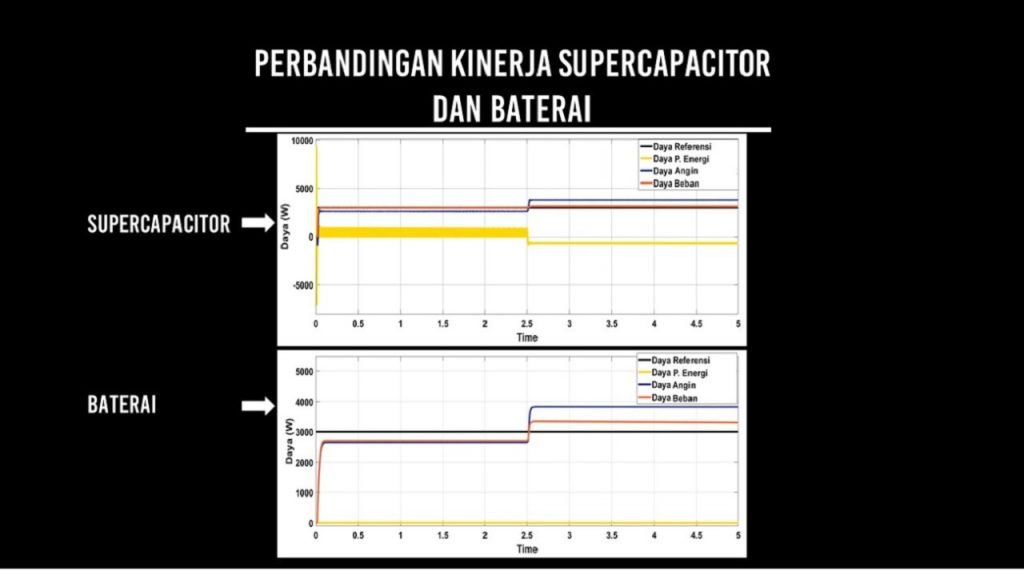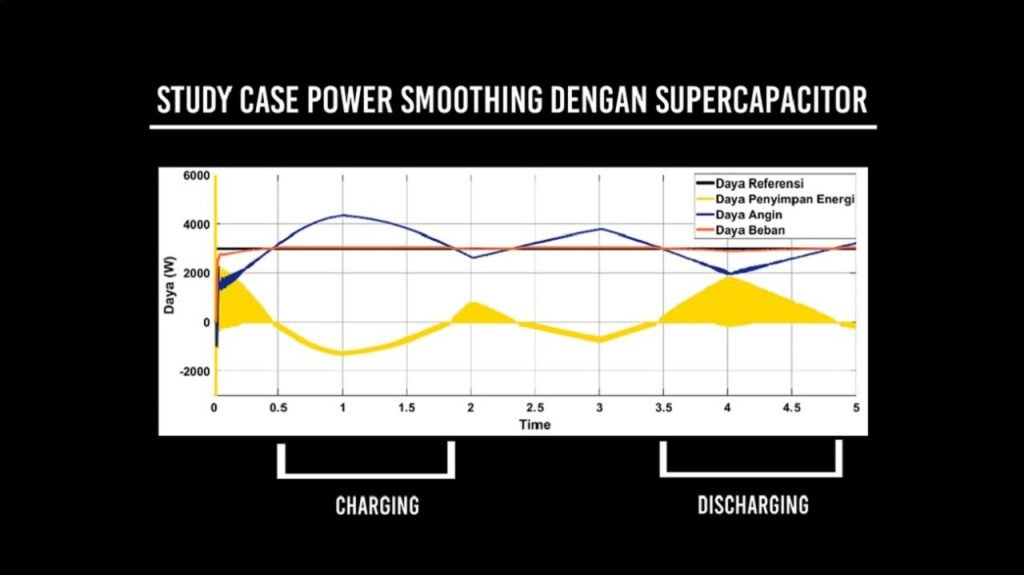ITS Students Research Supercapacitors as Wind Energy Smoother

The results of the LIP1ST Team test were a comparison of the performance of the supercapacitor and battery as a medium for storing wind turbine energy.
ITS Campus, ITS News – The use of wind as a substitute for electricity-producing energy has begun to be widely used, but the very fluctuating characteristics of wind require an energy storage medium that is very sensitive to respond to power. This is what is being researched by many students of the Sepuluh Nopember Institute of Technology (ITS) who are members of the LIP1ST Team, regarding the ability of supercapacitors as an alternative to batteries in stabilizing the power (power smoothing) of wind turbines.
Mohammad Arian Rahmatullah, Muhammad Haikal, and Ilul Rohman are three students of the ITS Electrical Engineering Department, raised this research. The topic that departed from the research of the Laboratory of Instrumentation, Measurement, and Power System Identification (LIPIST) of the ITS Electrical Engineering Department, originated from the fact that there is limited fossil energy in Indonesia today.
This is suitable with the statement given by the Minister of Energy and Mineral Resources (ESDM) RI Arifin Tasrif that Indonesia’s petroleum reserves are sufficient to meet the needs of the next nine years, assuming there are no reserves of fossil energy.

(from left) Ilul Rohman, Mohammad Arian Rahmatullah, and Muhammad Haikal, members of the LIP1ST Team of Wind Energy Smoother researchers.
Besides, the Head of the LIP1ST Team, Mohammad Arian Rahmatullah, added that this research was also based on the considerable potential of wind energy in Indonesia. Based on data from the Ministry of Energy and Mineral Resources, Indonesia’s wind power potential reaches 60,647 megawatts. But until now, less than 1/6 of the installed capacity has been utilized. “Because only a few are installed, so it is no less important to do optimization so that the energy generated is not wasted,” said the student who is familiarly called Arian.
Also, the use of batteries as an energy storage medium has its drawbacks. The high level of wind speed fluctuation results in the lack of power being captured by the battery as an energy storage medium. The small power density of the battery also causes a long time to be fully charged.
“Batteries have low charging and discharging capabilities, relatively short life cycles, and are flammable because they use chemical processes,” added the student from Sampang, Madura.
Therefore, continued Arian, an energy storage medium that has a higher power density was tested, namely the supercapacitor. To test this, a block diagram modeling was made in the Mathlab Simulink software. First, several components such as wind turbine, rectifier, boos controller, boost converter, bidirectional converter, bidirectional controller, and energy storage are arranged in such a way as to form a scheme.
The test results of the LIP1ST Team are in the form of a case study chart of modeling the supercapacitor as a storage medium for wind turbine energyFurthermore, continued Arian again, several parameters such as rated capacitance, rated voltage, initial voltage, operating temperature, and others were also filled according to real conditions in the field. After that, a case study is inputted in three conditions are the wind speed changes with the constant load power, the wind speed is constant with the load power changes, and the wind speed with the load power changes. “Either the battery or the supercapacitor, we tested the charging and discharging power in a very short time, which is just 5 seconds,” he said.
After being tested, the research, which was supervised by Vita Lystianingrum Budiharto Putri ST MSc PhD, found that supercapacitors have excellent and fast responsiveness in short time intervals. Within 5 seconds, with the wind turbine’s very fluctuating power, the supercapacitor can capture optimally. When the power exceeds the load, the power will be completely saved. When the input power is less than the load, a reserve power will be supplied to stabilize the power generated by the wind turbine.
“Even though the price is a little more expensive, the lifetime of the supercapacitor is three times longer than the battery, and we believe, it is possible that in the future the price of supercapacitor will be able to compete with other energy storage,” he said confidently. (mad/ris/ITS Public Relations)
Related News
-
ITS Rises to Second Rank in Most National PKM Funding
ITS Campus, ITS News – Strengthening its determination in the scientific field, the Institut Teknologi Sepuluh Nopember (ITS) succeeded
January 15, 2021 20:01 -
Examining Kenny, the Best ITS Bachelor Graduate with a GPA of 3.94
ITS Campus, ITS News — Educating for 3.5 years at the Institut Teknologi Sepuluh Nopember (ITS) did not prevent Benedictus
January 15, 2021 20:01 -
Inspirational, Deaf ITS Graduates Graduated with Cumlaude Predicate
ITS Campus, ITS News — An inspiring story was also present at the 129th Graduation Ceremony of the Institut Teknologi
January 15, 2021 20:01 -
129th Graduation: ITS Graduates 1,355 Candidate Leaders
ITS Campus, ITS News – Institut Teknologi Sepuluh Nopember (ITS) again held a graduation procession for its students through the
January 15, 2021 20:01

